Rottnest Island, in the Indian Ocean southwest of Perth, is a popular destination for campers, beach-lovers and day-trippers. There are lots of places like that, I suppose - but Rottnest has a particular fascination for naturalists, and I was delighted when circumstances near the end of our trip, on September 21, 2013, opened up a chance for me to catch a ferry from the Fremantle wharf and head out for a day on the island.
A few of our little group decided, at the very end of our trip, to brave the seas to Rottnest. They may not have shared my enthusiasm for smallish marsupials, but it was certainly with visions of Quokkas dancing in my head that I left Eileen and our less boat-friendly companions to shop in Fremantle, and boarded the ferry for a wave-tossed crossing.
Don't let the placid waters in the upper photograph fool you – that was a rough trip! Anyway, once I got my legs again I decided that the best way to explore the island was by renting a bicycle. Now, I don't mind telling you that it's been a long time since I've ridden a bicycle, but I did manage, somehow, to find my way out of the small island port and set off on the road to the salt lakes just behind it.
The salt lakes support large populations of brine shrimp, and this makes them excellent places to look for water birds (especially as the road follows right along the lake edge).
The reddish vegetation crowding onto the Salt Lake Beach is samphire, a salt-resistant member of the goosefoot family (Chenopodiaceae), At least two species of Sarcocornia and one or two Tecticornia grow on the island; I will hazard a guess that the reddish plants you see here are Shrubby Samphire (Tecticornia halocnemioides).
Rottnest is not alien-free; this is Onion Weed or Hollow-stemmed Asphodel (Asphodelus fistulosus), a Mediterranean plant established as a weed in many parts of Australia.
Among the birds visiting the salt lakes are Australian Shelduck (Tadorna tadornoides). This is a male. lacking the white marking around the eyes of females.
Islands in the lake are protected nesting grounds for the Fairy Tern (Sternula nereis), a declining species listed as Vulnerable by Birdlife International, but I saw none on my visit.
The birding highlights of Rottnest, however, are so identified with the island that they are known locally as Rottnest Snipe. It was to see them that I entrusted myself to my long-forgotten cycling skills.
Ornithologists call them Banded Stilt (Cladorhynchus leucocephalus), and they are certainly the most unusual of the small stilt and avocet family (Recurvirostridae). I had only seen them once before, on a birding trip to the salt pans near Adelaide, South Australia, in 1970.
It is not that Banded Stilts are particularly unusual-looking. In fact, they are very beautiful birds. It is their life history that has attracted attention, and, in particular, their habit of breeding in a immense numbers on ephemeral waters in the Australian interior. Because the very existence of such waters is unpredictable, nesting banded stilts are particularly hard birds to find.
In fact, it wasn't until 1930 that a nesting colony was finally found by an ornithologist. How the birds know which of the usually empty lake beds in the desert back country hold water in any given year is still something of a mystery. At Rottnest, they are only non-breeding visitors, arriving after the inland lakes dry up in the summer heat.
Don't let the placid waters in the upper photograph fool you – that was a rough trip! Anyway, once I got my legs again I decided that the best way to explore the island was by renting a bicycle. Now, I don't mind telling you that it's been a long time since I've ridden a bicycle, but I did manage, somehow, to find my way out of the small island port and set off on the road to the salt lakes just behind it.
The salt lakes support large populations of brine shrimp, and this makes them excellent places to look for water birds (especially as the road follows right along the lake edge).
The reddish vegetation crowding onto the Salt Lake Beach is samphire, a salt-resistant member of the goosefoot family (Chenopodiaceae), At least two species of Sarcocornia and one or two Tecticornia grow on the island; I will hazard a guess that the reddish plants you see here are Shrubby Samphire (Tecticornia halocnemioides).
Rottnest is not alien-free; this is Onion Weed or Hollow-stemmed Asphodel (Asphodelus fistulosus), a Mediterranean plant established as a weed in many parts of Australia.
Among the birds visiting the salt lakes are Australian Shelduck (Tadorna tadornoides). This is a male. lacking the white marking around the eyes of females.
Islands in the lake are protected nesting grounds for the Fairy Tern (Sternula nereis), a declining species listed as Vulnerable by Birdlife International, but I saw none on my visit.
The birding highlights of Rottnest, however, are so identified with the island that they are known locally as Rottnest Snipe. It was to see them that I entrusted myself to my long-forgotten cycling skills.
Ornithologists call them Banded Stilt (Cladorhynchus leucocephalus), and they are certainly the most unusual of the small stilt and avocet family (Recurvirostridae). I had only seen them once before, on a birding trip to the salt pans near Adelaide, South Australia, in 1970.
It is not that Banded Stilts are particularly unusual-looking. In fact, they are very beautiful birds. It is their life history that has attracted attention, and, in particular, their habit of breeding in a immense numbers on ephemeral waters in the Australian interior. Because the very existence of such waters is unpredictable, nesting banded stilts are particularly hard birds to find.
In fact, it wasn't until 1930 that a nesting colony was finally found by an ornithologist. How the birds know which of the usually empty lake beds in the desert back country hold water in any given year is still something of a mystery. At Rottnest, they are only non-breeding visitors, arriving after the inland lakes dry up in the summer heat.
Feeding among the Banded Stilts were a few White-headed Stilts (Himantopus leucocephalus), Australian representatives of the "typical" stilts found in other parts of the world. Among other things, you can tell them apart by their black backs and much longer legs.
I watched the stilts for some time, until they apparently grew tired of me and flew off to the middle of the lake.
Banded Stilts, by the way, swim well despite their long legs, and are seemingly adept at snatching morsels of food from the water's surface.
Finally (persuaded by a bit of rain) I decided it was time to head back to town. I took a brief rest in the small Rottnest Island Cemetery, which contains only a few nineteenth-century headstones (the cemetery was for white people; around 350 aboriginals were buried elsewhere, in unmarked graves).
There were some attractive flowers around, but they were, I'm afraid, mostly weeds; the upper photo is of One-leaf Cape tulip (Moraea flaccida), an import from South Africa.
The town, I was told, was the best place to find Quokkas (notice, for example the little bump in the centre of the road ahead of me).
Unlike their mainland cousins, they have taken advantage of (and seem quite unconcerned by) our presence.
They certainly don't see us as a threat (they are now popular subjects for selfies), though they risk being harmed by our interest in them. It is illegal to touch, or hug, one, and vegemite makes them sick. Well, I don't care for it myself. Anyway, at least it's been some years since brain-dead idiots used the animals as targets for 'quokka soccer', though some recent quokka deaths suggest that vicious morons still get to the island occasionally.
Probably the best way to appreciate them is to take the afternoon Quokka walk, in our case led by an enthusiastic (despite the rain) local guide.
This gave me not only a chance to get better acquainted with the Quokkas, but to see a bit more of the island's countryside. That included a bit of its remnant woodland, which is dominated today by Melaleuca lanceolata and Callitris preissii, known respectively as Rottnest Island Teatree and Rottnest Island Pine though both grow widely on the mainland. This web site provides a good introduction to the island's fauna and flora (including the Quokkas), if you want to know more.
Of course there are exotics too, like this Common Fig (Ficus carica).
I was able to get close to a few birds, too: here is an Australian Pied Oystercatcher (Haematopus longirostris) patrolling the edge of a lagoon.
The Australian Raven (Corvus coronoides) is ubiquitous, and tame, on the island.
We had no trouble finding Quokkas, including these two grazing placidly on a nearby sward. Despite the domestic impression this photo may give you, Quokkas appear to be promiscuous, with the larger males battling each other for access to the smaller females. According to the latest volume of the Handbook of the Mammals of the World, "After copulation males often lose interest in the female, and she may then mate with additional males". Sort of like humans.
Even their droppings were everywhere.
Quokkas are, in fact, quite urban creatures on Rottnest: the vegetarian equivalent of raccoons. This one shares the photo with another largely urbanized creature, a Pacific Black Duck (Anas superciliosa).
If they are not eating the harmful things that humans aren't supposed to give them, Quokkas live on seeds, leaves, stems and other vegetable matter; on Rottnest they have been reported to dine on forty different species of plants.

















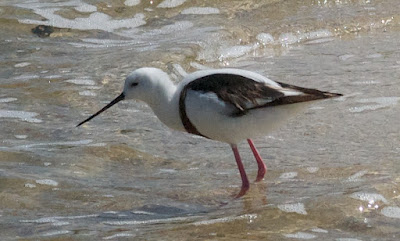
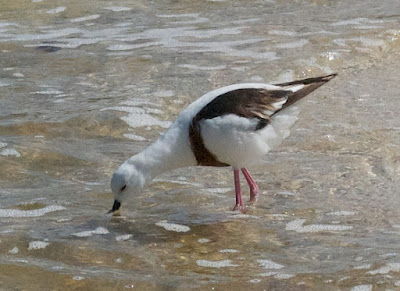












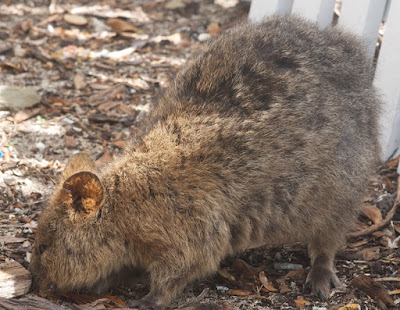







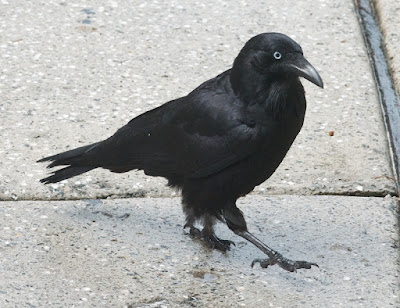




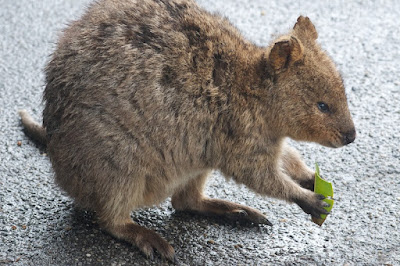


No comments:
Post a Comment